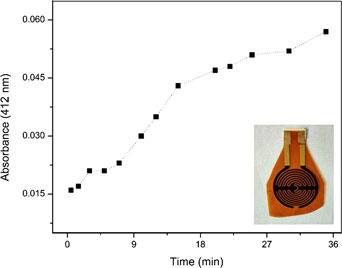Crossref Citations
This article has been cited by the following publications. This list is generated based on data provided by
Crossref.
Ramírez‐Sánchez, Karla
Alvarado‐Hidalgo, Fernando
Zamora‐Sequeira, Roy
Sáenz‐Arce, Giovanni
Rojas‐Carrillo, Oscar
Avedaño-Soto, Esteban
Ruepert, Clemens
Mena‐Torres, Freylan
and
Starbird‐Pérez, Ricardo
2019.
Biosensor based on the directly enzyme immobilization into a gold nanotriangles/conductive polymer biocompatible coat for electrochemical detection of Chlorpyrifos in water.
MEDICAL DEVICES & SENSORS,
Vol. 2,
Issue. 5-6,
Ramírez Sánchez, Karla
Ledezma-Espinoza, Aura
Sánchez-Kopper, Andrés
Avendaño-Soto, Esteban
Prado, Mónica
and
Starbird Perez, Ricardo
2020.
Polysaccharide κ-Carrageenan as Doping Agent in Conductive Coatings for Electrochemical Controlled Release of Dexamethasone at Therapeutic Doses.
Molecules,
Vol. 25,
Issue. 9,
p.
2139.
Delbecq, F.
Kondo, T.
Sugai, S.
Bodelet, M.
Mathon, A.
Paris, J.
Sirkia, L.
Lefebvre, C.
and
Jeux, V.
2021.
A study for the production of a polysaccharide based hydrogel ink composites as binder for modification of carbon paper electrodes covered with PEDOT:PSS.
Colloids and Surfaces A: Physicochemical and Engineering Aspects,
Vol. 628,
Issue. ,
p.
127380.
Ledezma-Espinoza, Aura
Rodríguez-Quesada, Laria
Araya-Leitón, María
Avendaño-Soto, Esteban D.
and
Starbird-Perez, Ricardo
2022.
Modified cellulose/poly(3,4-ethylenedioxythiophene) composite as photocatalyst for the removal of sulindac and carbamazepine from water.
Environmental Technology & Innovation,
Vol. 27,
Issue. ,
p.
102483.
Wang, Xiao
Sun, Xiaotong
Gan, Donglin
Soubrier, Manon
Chiang, Hsin-Yin
Yan, Liwei
Li, Yingqi
Li, Junjun
Yu, Shuang
Xia, Yang
Wang, Kefeng
Qin, Qiaozhen
Jiang, Xiaoxia
Han, Lu
Pan, Taisong
Xie, Chaoming
and
Lu, Xiong
2022.
Bioadhesive and conductive hydrogel-integrated brain-machine interfaces for conformal and immune-evasive contact with brain tissue.
Matter,
Vol. 5,
Issue. 4,
p.
1204.
Rodríguez-Quesada, Laria
Ramírez-Sánchez, Karla
León-Carvajal, Sebastián
Sáenz-Arce, Giovanni
Vásquez-Sancho, Fabián
Avendaño-Soto, Esteban
Montero-Rodríguez, Juan José
and
Starbird-Perez, Ricardo
2023.
Evaluating the Effect of Iron(III) in the Preparation of a Conductive Porous Composite Using a Biomass Waste-Based Starch Template.
Polymers,
Vol. 15,
Issue. 11,
p.
2560.



